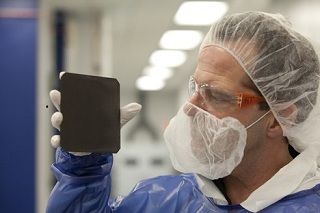Renewable Energy Technology Improving Performance, Reducing Costs
Here’s some good news in the photovoltaics world: the first about a new record in solar efficiency and the second about a super-absorbent solar cell.
I’m reminded of a conversation I have frequently with clean energy nay-sayers.
As renewable energy is built squarely on high-tech, what is the certain outcome? Ever-improving performance and steadily declining costs.
Does anybody think we’ll still be burning coal and driving Hummers in the year 2050? Of course not.
Why? Among other things, because the trajectory for solar, wind, and the others is so rapidly pushing the cost per Watt down.
Then why aren’t we embracing the future, working on these technologies full-bore, while doing the right thing for the environment at the same time?


Let’s hope they can use some more conventional materials, using Indium is on par with using Gold and Platinum, might have some real problems scaling down. I would bet on other groups with lower efficiencies but easier scaling costs, like the guys trying to make carbon based anode materials. But don’t put me in with the clean energy nay-sayers, I have lots of hope with science and technology providing cleaner means of energy.
But even if the increased the efficiency to 50% and in addition reduced the cost, that still would not solve the problem if intermittency.
Folks trying to run their washer and dryer at night from stored PV power would not be the best use of the technology.
However, according to the US Department of Energy’s Energy Information Administration, just behind the refrigerator at 14%, is home lighting at 9%. Interestingly, no single appliance dominated the use of electricity.
The combination of battery storage and LED lighting works quite well with PV, and could reduce fossil energy consumption considerably if widely applied – it’s all about appropriate application.
Personally, PV is not at all my preferred form of solar, but it’s not without it’s uses – for which people must apply it reasonably, and should wherever appropriate.
Concentrated Solar Power (CSP) is the best solution in my estimation – merely 100 solar plants, each a mile square and equipped with pumped hydro storage (now already in significant use in the US or molten salt storage, strung across our Sunbelt with high-voltage direct current as part of a grid upgrade, would satisfy all our present electrical needs, and could be scaled easily to satisfy new needs (transport, etc.).
Some interesting and useful information on energy storage here:
http://www.eia.gov/todayinenergy/detail.cfm?id=6910
There is already a major site study in the best regions for CSP in six western states, to identify the most appropriate and least environmentally impactful and vulnerable sites, so as to preselect them for fast-tracking solar harvesting. Concerns like the desert tortoise and other wildlife, weather patterns and the potential for dust storms, moving sand dunes,etc., will be accounted for.
Here’s some info on the study:
http://solareis.anl.gov/
Look here:
http://solareis.anl.gov/
http://www.eia.gov/todayinenergy/detail.cfm?id=6910
http://en.wikipedia.org/wiki/Pumped-storage_hydroelectricity
Craig,
I’m not a nay-sayer… But I do think we’ll still have ~10-15% coal on the grid by 2050. In the near-term we’ll see natural gas continue to rapidly gain market share, but as the nuclear fleet starts to become decommissioned, the loss of nuclear power will out-pace the ramp-up of wind, solar, and geothermal energy… so coal will stay ~25% of the grid through the death of the nuclear power industry. By then we’ll see enough of an increase in the price of natural gas (the low-cost fracking reserves will have become depleted), that further growth in renewables will be eating into NG as well as coal…
Coal is not going to go down quickly. It will be gradually diminishing, but it won’t go away tomorrow. That’s one reason why I support the construction of ultra-efficient coal plants with well-scrubbed exhaust if that construction corresponds to decommissioning older plants; and why I oppose EV’s – growth in constant overnight baseload demand will only support the ideal market for continued coal power… making it even harder to shut the old plants down.
There’s a difference between nay-saying and being realistic. This is a marathon… sprinting only means you won’t cross the finish line.
😉
Good analogy. I’ll be interested in your response to my piece on Obama’s letter to my friend; I guess I’ll extend coal out another couple of decades.